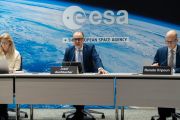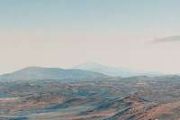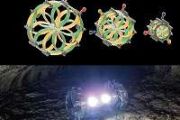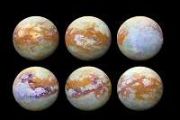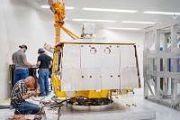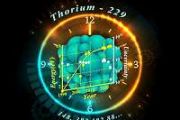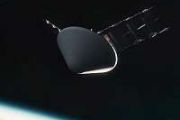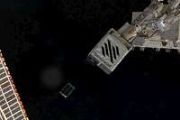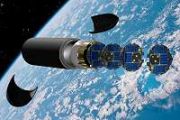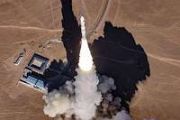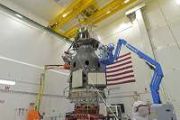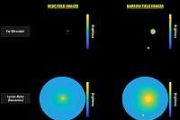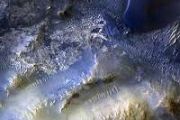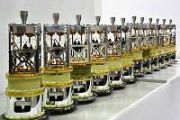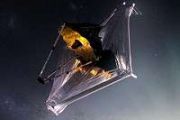
Copernical Team
Hong Kong spearheads lunar robotics initiative for national space program
 China's Hong Kong Special Administrative Region (HKSAR) has taken a pivotal step in contributing to national space ambitions with the launch of the Hong Kong Space Robotics and Energy Center. This newly established facility is set to play a significant role in China's upcoming Chang'e-8 lunar mission.
The center, operating under the InnoHK Research Clusters and led by the Hong Kong Univers
China's Hong Kong Special Administrative Region (HKSAR) has taken a pivotal step in contributing to national space ambitions with the launch of the Hong Kong Space Robotics and Energy Center. This newly established facility is set to play a significant role in China's upcoming Chang'e-8 lunar mission.
The center, operating under the InnoHK Research Clusters and led by the Hong Kong Univers Varda launches third space capsule to advance hypersonic navigation tech
 Varda Space Industries, Inc., a company focused on microgravity-enabled life sciences and atmospheric reentry solutions, has successfully deployed its third orbital capsule, W-3, marking its second mission of the year. This achievement follows closely on the heels of its W-2 mission, which safely touched down in Australia on February 27, 2025.
The W-3 spacecraft, mounted on a Rocket Lab Pi
Varda Space Industries, Inc., a company focused on microgravity-enabled life sciences and atmospheric reentry solutions, has successfully deployed its third orbital capsule, W-3, marking its second mission of the year. This achievement follows closely on the heels of its W-2 mission, which safely touched down in Australia on February 27, 2025.
The W-3 spacecraft, mounted on a Rocket Lab Pi SpaceX launches more Starlink satellites 12 hours after Crew-10 sent to ISS
 SpaceX launched another batch of Starlik satellites into orbit Saturday morning, a little more than 12 hours after the private company teamed up with NASA to send four astronauts to the International Space Station - also from Florida.
In addition, SpaceX sent 74 satellites from Vandenberg Space Force Base on a rideshare mission called Transporter 13 late Friday from California.
SpaceX launched another batch of Starlik satellites into orbit Saturday morning, a little more than 12 hours after the private company teamed up with NASA to send four astronauts to the International Space Station - also from Florida.
In addition, SpaceX sent 74 satellites from Vandenberg Space Force Base on a rideshare mission called Transporter 13 late Friday from California. ICEYE expands satellite fleet with latest launch and unveils advanced Gen4 imaging system
 ICEYE, a global frontrunner in synthetic aperture radar (SAR) satellite-based Earth Observation and disaster monitoring, has deployed four new satellites, each equipped with 25 cm resolution capabilities. This latest launch strengthens ICEYE's already unmatched SAR constellation, further advancing its capacity to support natural disaster response and national security missions. Notably, the laun
ICEYE, a global frontrunner in synthetic aperture radar (SAR) satellite-based Earth Observation and disaster monitoring, has deployed four new satellites, each equipped with 25 cm resolution capabilities. This latest launch strengthens ICEYE's already unmatched SAR constellation, further advancing its capacity to support natural disaster response and national security missions. Notably, the laun EZIE satellites begin mission to map Earth's auroral electrojets
 NASA's Electrojet Zeeman Imaging Explorer (EZIE) mission is now in space and preparing to study powerful electric currents in Earth's upper atmosphere following a successful launch and satellite deployment. Liftoff took place at 11:43 p.m. PDT on March 14, 2025, from Vandenberg Space Force Base in California, with the deployment of all three CubeSats completed around 2 a.m. PDT the next day.
NASA's Electrojet Zeeman Imaging Explorer (EZIE) mission is now in space and preparing to study powerful electric currents in Earth's upper atmosphere following a successful launch and satellite deployment. Liftoff took place at 11:43 p.m. PDT on March 14, 2025, from Vandenberg Space Force Base in California, with the deployment of all three CubeSats completed around 2 a.m. PDT the next day. TOI-1453 system hosts contrasting super-Earth and low-mass sub-Neptune
 Astronomers have identified two planets orbiting the star TOI-1453, located approximately 250 light years from Earth in the constellation Draco. The system, which includes a super-Earth and a sub-Neptune, provides an intriguing opportunity to study planetary types that are prevalent across the galaxy but missing from our own solar system. The discovery offers promising avenues for future explora
Astronomers have identified two planets orbiting the star TOI-1453, located approximately 250 light years from Earth in the constellation Draco. The system, which includes a super-Earth and a sub-Neptune, provides an intriguing opportunity to study planetary types that are prevalent across the galaxy but missing from our own solar system. The discovery offers promising avenues for future explora Rocket Lab launches QPS-SAR-9 satellite in latest Electron mission
 Rocket Lab USA, Inc. (Nasdaq: RKLB) successfully completed its 61st Electron launch, marking the company's second mission for Japanese satellite operator Institute for Q-shu Pioneers of Space, Inc. (iQPS).
The mission, named "The Lightning God Reigns," lifted off from Launch Complex 1 at Mahia, New Zealand, on March 15, 2025, at 1:00 p.m. NZDT (00:00 UTC). The Electron rocket delivered iQP
Rocket Lab USA, Inc. (Nasdaq: RKLB) successfully completed its 61st Electron launch, marking the company's second mission for Japanese satellite operator Institute for Q-shu Pioneers of Space, Inc. (iQPS).
The mission, named "The Lightning God Reigns," lifted off from Launch Complex 1 at Mahia, New Zealand, on March 15, 2025, at 1:00 p.m. NZDT (00:00 UTC). The Electron rocket delivered iQP Musk says Starship to depart for Mars at end of 2026
 SpaceX founder Elon Musk said Saturday its massive Starship rocket would leave for Mars at the end of 2026 with Tesla humanoid robot Optimus onboard, adding that human landings could follow "as soon as 2029."
"Starship departs for Mars at the end of next year, carrying Optimus. If those landings go well, then human landings may start as soon as 2029, although 2031 is more likely," Musk said
SpaceX founder Elon Musk said Saturday its massive Starship rocket would leave for Mars at the end of 2026 with Tesla humanoid robot Optimus onboard, adding that human landings could follow "as soon as 2029."
"Starship departs for Mars at the end of next year, carrying Optimus. If those landings go well, then human landings may start as soon as 2029, although 2031 is more likely," Musk said ISRO advances space tech with SPADEX undocking and cryogenic engine milestone
 India's space program marked a significant stride forward in March 2025 with a trio of successful operations that underscore the growing sophistication and efficiency of the Indian Space Research Organisation (ISRO). From a milestone in-orbit maneuver involving its SPADEX satellite duo to innovations in cryogenic engine testing, ISRO's achievements reflect a focused drive to advance indigenous c
India's space program marked a significant stride forward in March 2025 with a trio of successful operations that underscore the growing sophistication and efficiency of the Indian Space Research Organisation (ISRO). From a milestone in-orbit maneuver involving its SPADEX satellite duo to innovations in cryogenic engine testing, ISRO's achievements reflect a focused drive to advance indigenous c Two US 'bumped' astronauts to return to Earth on Tuesday: NASA
 A pair of US astronauts stuck for more than nine months on the International Space Station will be returned to Earth on Tuesday evening, NASA said.
Butch Wilmore and Suni Williams are to be transported home with another American astronaut and a Russian cosmonaut aboard a SpaceX Crew Dragon craft, which arrived at the ISS early Sunday.
The stranded duo have been on the ISS since June aft
A pair of US astronauts stuck for more than nine months on the International Space Station will be returned to Earth on Tuesday evening, NASA said.
Butch Wilmore and Suni Williams are to be transported home with another American astronaut and a Russian cosmonaut aboard a SpaceX Crew Dragon craft, which arrived at the ISS early Sunday.
The stranded duo have been on the ISS since June aft 



